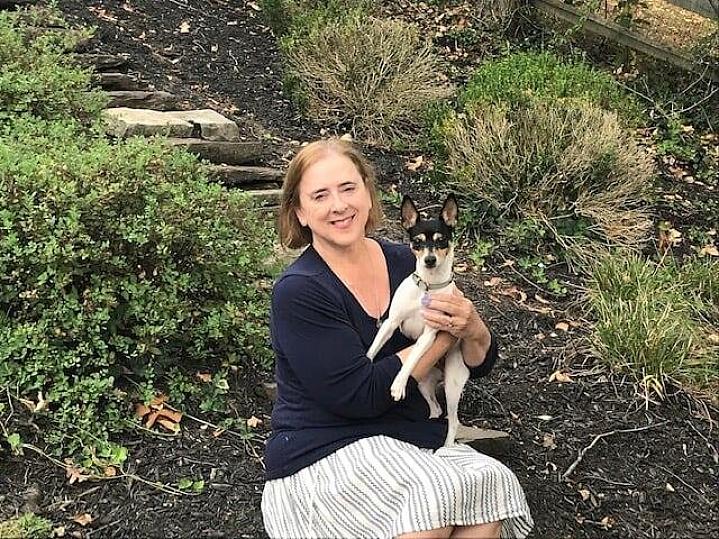Q&A
Dr. Elaine Ostrander on NIH’s Dog Genome Project
 Dr. Elaine Ostrander Photo courtesy of Mary Ellen Urick, National Human Genome Research Institute
Dr. Elaine Ostrander Photo courtesy of Mary Ellen Urick, National Human Genome Research InstituteExcerpts from our conversation with Dr Elaine Ostrander, an expert on dog genetics at NIH’s National Human Genome Research Institute.
NIHNiH: What can you learn by studying different types of dogs?
Ostrander: When you go to the dog park, you really see the variability in dogs. Even though they’re all a single species, size can differ by 40-fold. There are differences in leg length, coat color, skull shape, behavior, and more.
Differences in body shape between breeds are giving us insight into genes responsible for human diseases that we didn't know about before. So genesStretches of DNA you inherit from your parents that define features, such as eye color or your risk for certain diseases. that are associated with being a really big dog, when mutated in humans are associated with obesity, or metabolic syndrome. And genes that contribute to ear shape in dogs are associated with deafness when mutated in humans. And genes linked to leg length, when mutated humans, are associated with osteoporosis.
Dogs have been really terrific for identifying single-gene traits and then developing targeted therapeutics against them. If you think about something like epilepsy, we know there are dozens of genes that can cause epilepsy in people. But within a given dog breed, there’s probably going to be just one or two. So it’s a great way to simplify all the variation that we face when we study human disease.
NIHNiH: What can studies of dogs tell us about human aging?
Ostrander: A lot of health conditions are diseases that arise with age, including many cancers. Humans live to be 60 to 80 years old and more. But the dog lifespan is really compressed. So we can study multiple generations in a shorter timeframe. We have the ability to look at grandparents, parents, offspring, and great grandchildren of dogs, because of their condensed lifespan.
Our lab is pretty focused on purebred dogs because different breeds have wildly different lifespans. Some of the really big breeds—like St. Bernards—frequently die at 8 years or so. Whereas with some of the small breeds, like toy poodles, we expect them to live to be 16, 17, or 18.
We've been really interested in understanding the genetics of size versus aging. We’ve found many of the genes that regulate body size in dogs. Now we want to match that up with aging and figure out what that relationship is.
NIHNiH: How did your lab get involved working with pet dogs and dog owners?
Ostrander: When we came to NIH in 2004, we found that many people wanted their dog to be part of the official NIH Dog Genome Project. It's been fun to work with dog owners.
We wanted to see dogs in their environment. We want to see herding dogs herd. We want to see hunting dogs hunt. We want to see guide dogs guide. The only way to do that is with citizen science in which regular people, like dog owners, collaborate with scientists to gather and share data.
We work with purebred dogs. So we know their lineage going back generation after generation. The American Kennel Club makes pedigrees freely available, with owner consent of course. And owners give us access to medical records, with written consent. We really know their genetics.
NIHNiH: Are you still are seeking samples from pet dogs?
Ostrander: Absolutely! On our website, we have a list of breeds where we still wish we had more dogs. Some of the work we're doing now is really worldwide. We get calls from Africa, from Vietnam, and from many island populations. We recently collected samples from Fiji, Bali, the Galapagos, and other islands.
We’ve been working with collaborators to get samples from dogs living in the Chernobyl power plant. We’re studying those populations and figuring out what’s going on with those dogs.
We’ve been able to get samples from animals that people thought were extinct in the wild, like the rare New Guinea singing dog. We were the first to show that they’re not extinct in the wild. There are still a few, but it’s time to protect them.
If somebody has interesting dogs, they should contact us. We want to hear from them!
NIH Office of Communications and Public Liaison
Building 31, Room 5B52
Bethesda, MD 20892-2094
nihnewsinhealth@od.nih.gov
Tel: 301-451-8224
Editor: Harrison Wein, Ph.D.
Managing Editor: Tianna Hicklin, Ph.D.
Illustrator: Alan Defibaugh
Attention Editors: Reprint our articles and illustrations in your own publication. Our material is not copyrighted. Please acknowledge NIH News in Health as the source and send us a copy.
For more consumer health news and information, visit health.nih.gov.
For wellness toolkits, visit www.nih.gov/wellnesstoolkits.